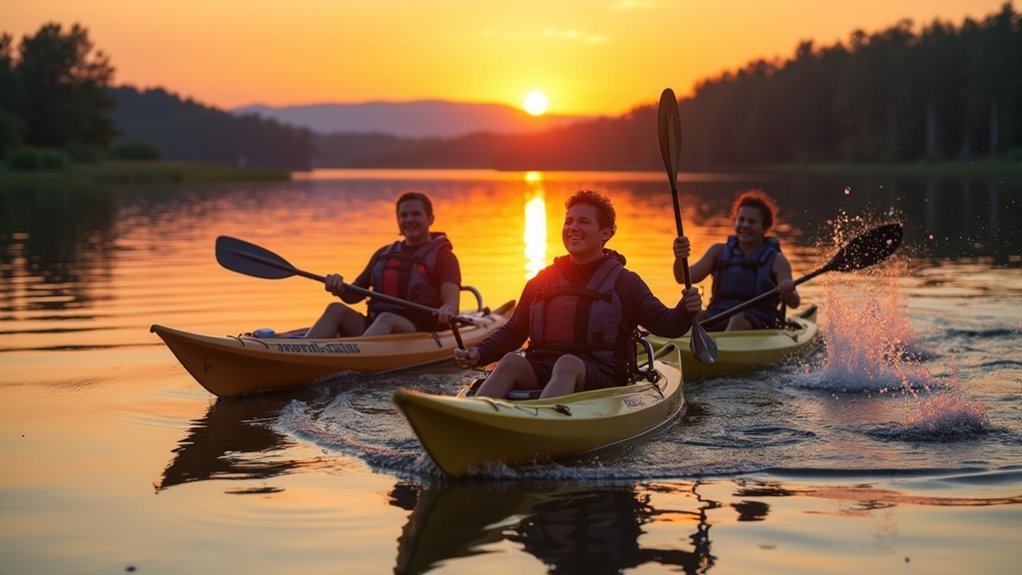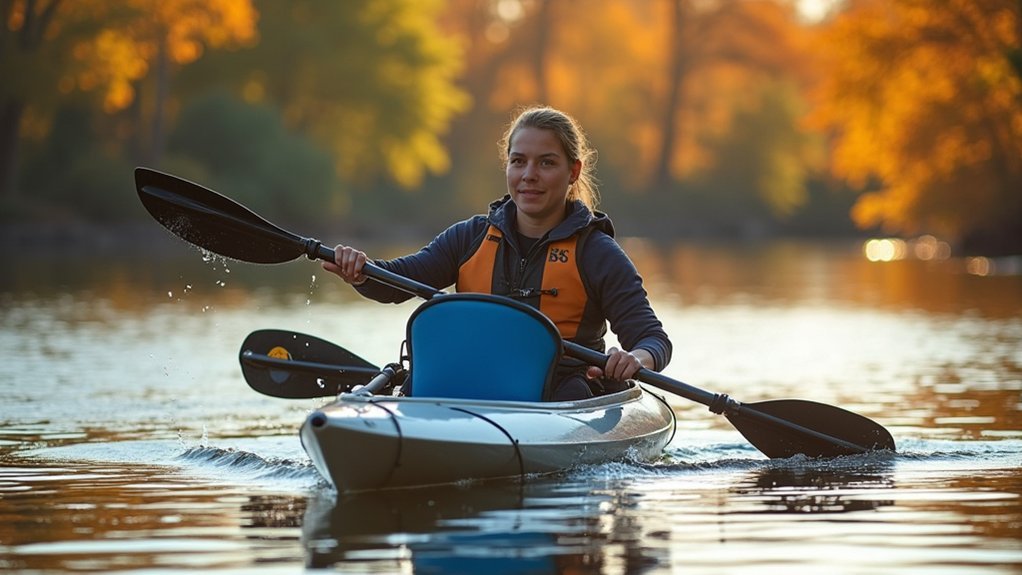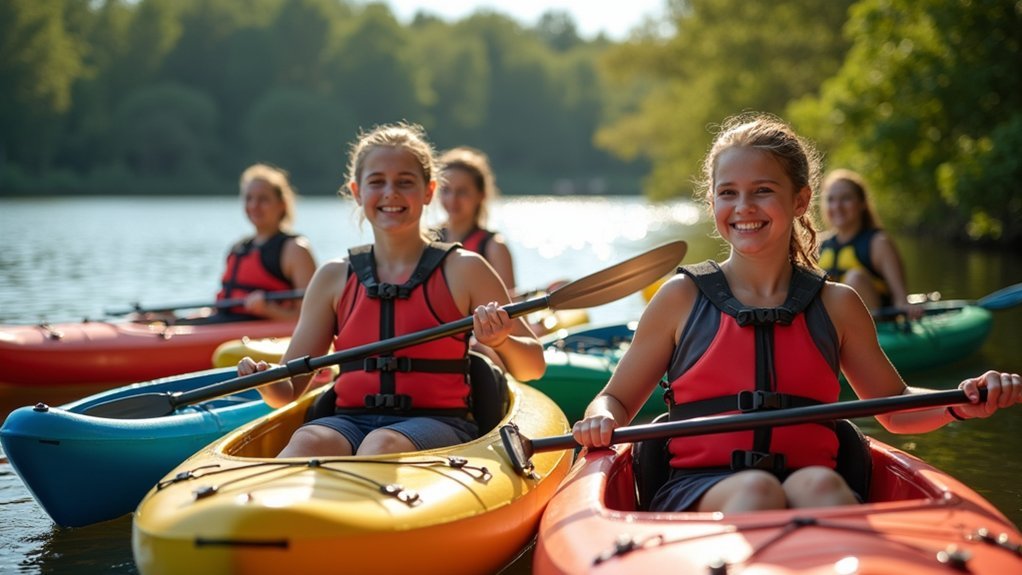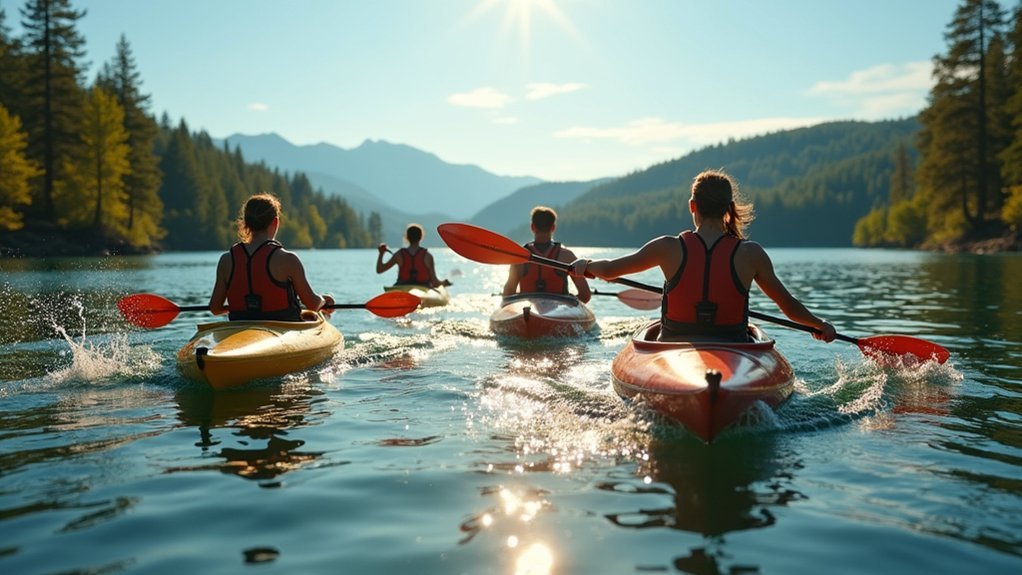Specialized adaptive kayak seats empower paralyzed paddlers with vital adjustable trunk support systems and side bolsters to maintain stability. You’ll need proper cushioning with closed-cell foam to protect your skin during extended outings, while regular repositioning prevents pressure sores. Transfer systems like wheelchair-accessible platforms and overhead assist bars help you enter and exit safely. Outriggers and wider kayaks provide essential stability for those with limited trunk control. These customized solutions open waterways to paddlers of all abilities.
Essential Components of Specialized Adaptive Kayak Seats

Five critical components transform standard kayaks into vessels accessible for paddlers with paralysis.
Adjustable side supports help maintain an upright position, ensuring stability while you’re on the water. Trunk support systems are essential if you have spinal cord injuries or reduced core strength, keeping you secure throughout your paddling session.
Proper support means freedom on the water, even with limited core strength or mobility challenges.
The seat’s ergonomic fit reduces strain during extended outings, while proper cushioning using closed-cell foam and breathable mesh fabric provides maximum skin protection—crucial for those with limited sensation.
Most importantly, look for customization options with removable or adjustable support points that can be tailored to your specific needs.
These specialized seats typically work with existing hardware attachments, making installation straightforward while still offering the stability and support you’ll need to enjoy the freedom of kayaking. For optimal installation, ensure your kayak has scupper holes near the back of the seat pan to properly secure the adaptive fixture.
Pressure Management and Skin Protection Strategies
While the excitement of kayaking beckons, proper skin protection remains essential for paralyzed paddlers who face unique risks during extended water sessions. You’ll need to monitor for early warning signs like redness or swelling in pressure-prone areas. Regular weight shifts and repositioning are vital preventive measures. Similar to how scientists demand rigorous evidence for cryptid claims, medical professionals emphasize the importance of documented skin checks for paddlers with paralysis.
| Protection Method | Benefits | Best For |
|---|---|---|
| Gel Cushions | Pressure distribution | Long sessions |
| Foam Inserts | Targeted support | Sensitive areas |
| Sheepskin Covers | Friction reduction | Air circulation |
| Specialized Seat Pads | Moisture control | Hot weather |
| Coccyx Cuts | Tailbone relief | Lower back issues |
Maintain proper body alignment and consider using outriggers for stability. Break longer paddling sessions into shorter intervals with accessible landing spots for rest. Always consult with medical professionals to create strategies tailored to your specific needs.
Transfer Systems for Safe Entry and Exit

Safe water entry and exit represents one of the biggest challenges for paralyzed paddlers after skin protection concerns.
Modern transfer systems address this through wheelchair-accessible platforms equipped with three-step changes and overhead assist bars for stability.
You’ll find systems designed with ADA compliance in mind, featuring durable materials like marine-grade aluminum and DHPE Starboard surfaces that provide essential grip.
Many platforms include adjustable handles and transfer boards that allow you to slide smoothly into position above your kayak seat.
For maximum independence, consider systems with kayak chariots that position your boat at wheelchair height.
These integration options work with various kayak models and can be mounted to existing docks or purchased as standalone units, giving you flexibility based on your specific needs and paddling locations.
Regular use of these transfer systems can significantly enhance the experience of paddlers like Julie who may have limited mobility on one side of their body after suffering a stroke.
Stability Solutions for Paddlers With Paralysis
Maintaining stability on water presents unique challenges for paddlers with paralysis, requiring specialized equipment and techniques to guarantee a safe, enjoyable experience. Outriggers provide essential lateral support, dramatically reducing tippiness for those with mobility limitations.
Wider kayaks offer inherent stability, while adaptive seats with lateral supports help compensate for limited trunk control.
You’ll find specialized stabilizing weights can be strategically placed at the bottom of your kayak for additional security. Flat hulls provide greater primary stability, making them an excellent choice for paddlers with paralysis.
For ongoing improvement, consider paddling classes that teach bracing techniques and core stabilization exercises tailored to your abilities. Many adaptive programs offer free or low-cost training with volunteer assistance, ensuring you receive proper support while building confidence.
With these stability solutions, you’ll experience greater independence and enjoyment on the water regardless of physical limitations.
Customization Options for Individual Mobility Needs

Customizing your kayak to match your unique mobility needs transforms what might seem impossible into an achievable adventure on the water.
Customized kayaking solutions bridge the gap between physical limitations and boundless aquatic exploration.
With solutions like Redfish Custom Kayak Seats that are individually sculpted for your body type and kayak model, you’ll experience enhanced stability with their low center of gravity design.
You can select adjustable features that accommodate your specific requirements, from higher backrests promoting upright posture to integral hip pads providing secure fitting.
For those with paralysis, specialized supports including side bolsters and custom harnesses offer vital additional stability.
Creating Ability’s Universal Paddling Seats provide individually adjustable support points to match your physical needs, with breathable mesh fabric preventing skin irritation during extended paddling.
Seats designed from closed cell foam materials ensure they remain lightweight while providing essential support without absorbing water.
Consider gel or inflatable seat pads for added comfort on longer journeys.
Frequently Asked Questions
How Long Does It Take to Learn Adaptive Kayaking Techniques?
You’ll learn basic adaptive kayaking techniques in a few sessions, typically over 1-2 months with regular practice. Mastery depends on your specific needs and how often you’re able to participate in guided sessions.
What Insurance Coverage Is Available for Adaptive Kayaking Equipment?
When insuring your adaptive kayaking equipment, you’ll find options including equipment insurance, specialized adaptation-specific coverage, and customizable policies. Many providers offer free quotes and can tailor protection to your specific adaptive gear needs.
Can Paddlers With Respiratory Support Systems Participate in Kayaking?
Yes, you can kayak with respiratory support systems. You’ll need proper equipment adaptation, medical clearance, emergency planning, and possibly specialized training. Start with calm waters and gradually build your endurance and confidence.
How Do Weather Conditions Impact Adaptive Paddling Safety?
Weather conditions impact your adaptive paddling safety considerably. You’ll need to monitor winds, precipitation, temperature, and visibility more carefully. You’re at increased risk during sudden changes, so always check forecasts before heading out.
What Maintenance Is Required for Specialized Adaptive Kayaking Equipment?
You’ll need to regularly clean adaptive seats, outriggers, and paddles with mild soap. Inspect for wear, check attachment tightness, and maintain support systems. Don’t forget to store equipment away from sunlight when not in use.
In Summary
You’ve discovered how specialized kayak seats can transform your paddling experience despite paralysis. With proper pressure management, safe transfer systems, and stability features, you’re no longer limited by mobility challenges. Don’t hesitate to explore customization options that address your specific needs. Water freedom awaits—embrace the adventure with equipment that’s designed to support your independence and passion for paddling.





Leave a Reply